The Towson University community members we know who have died while serving their country.
Robert Lytle, Class of 1943
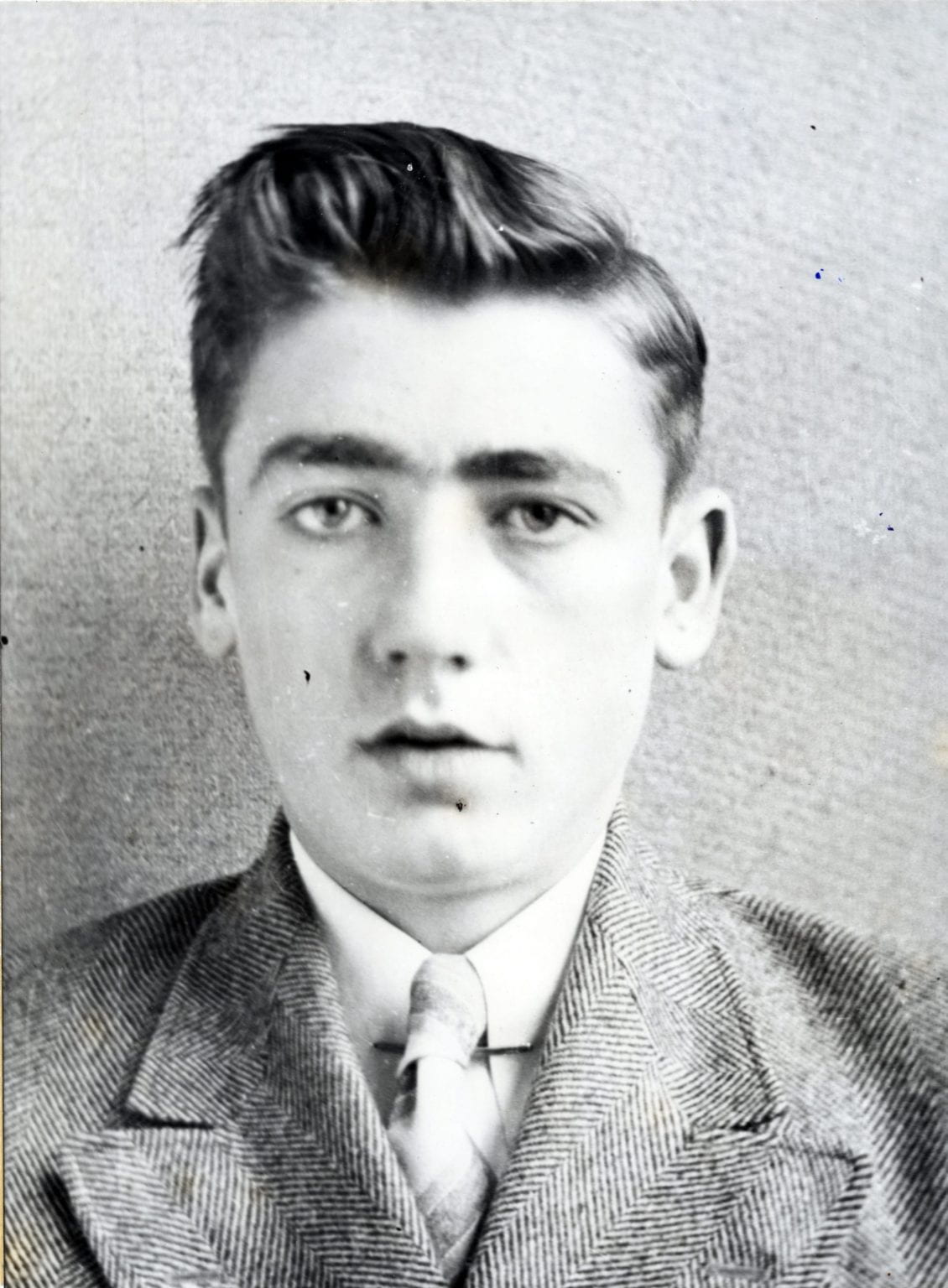
Photo from our Towson and WWII Collection
Robert Lytle is the first casualty we know about from the Towson University family.
He was a member of the Class of 1943, but was drafted before he completed his work at the State Teachers College at Towson (STC).
He was born in Govans and at some point his family moved to Towson. Lytle graduated from Towson High school in 1939 where he was involved in theater and the French Club. His 1942 draft card indicates that he worked at the Bendix Radio plant on Joppa Road in Towson. The fleeting mentions of him in the Tower Light speak to his sharp sense of fashion and skills as a dancer.
He enlisted in the United States Army on December 19, 1942.
On March 20, 1943, just four months after he joined the army, Lytle died at the Chicago Air Corps Hospital.
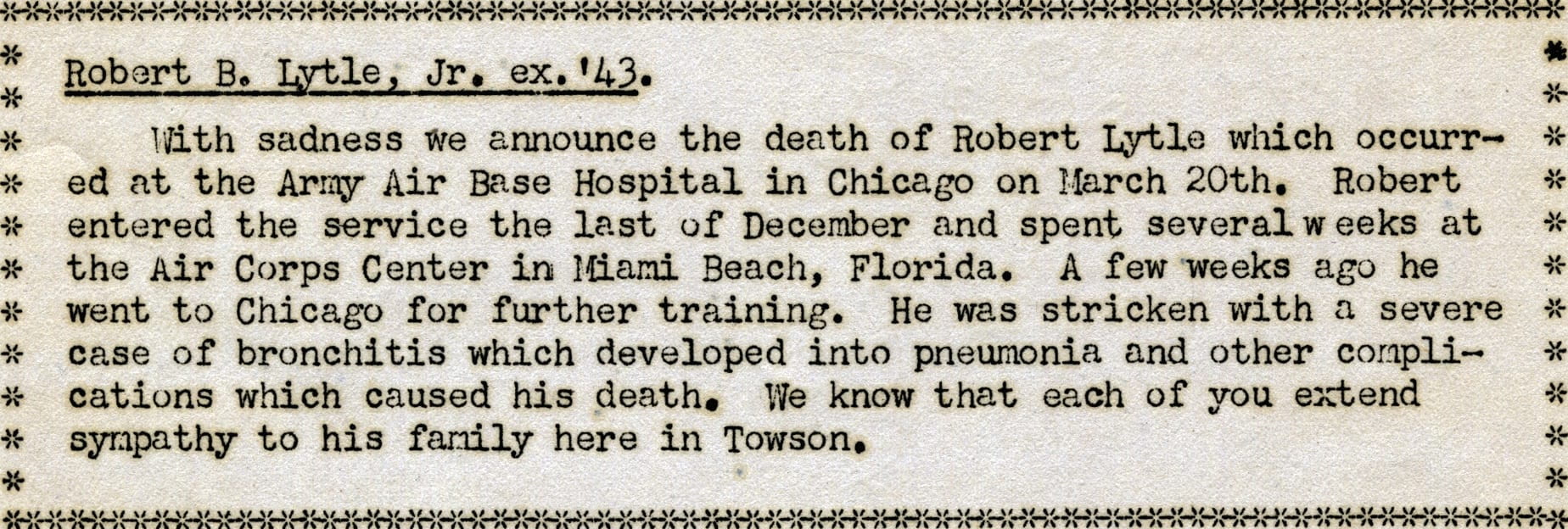
William Jett, Class of 1943
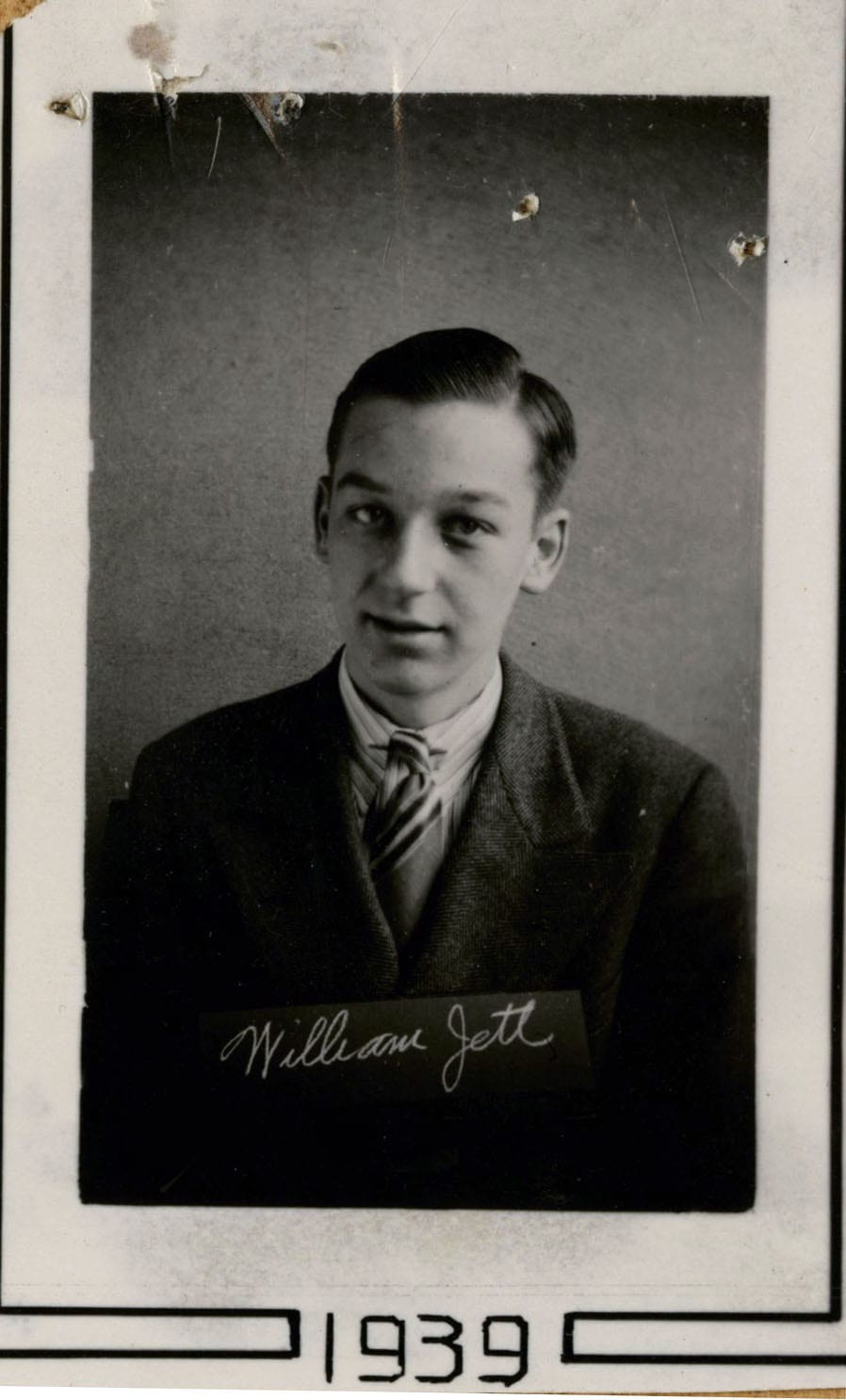
Photo from our Towson and WWII Collection
William Jett arrived on campus as a freshman in 1939 and immediately made a name for himself, probably helped in part by an active and popular older brother, James. Will became president of the freshman class, and created a sports paper. As a sophomore, he became the Student Council Treasurer and was elected Vice-President of the council when he was a junior.
Before he could graduate, however, he was called to serve and enlisted in the United States Army in April of 1942.
By September, he was in California for training, and soon he was in the Pacific Ocean theater, stationed on unnamed tropical islands.
His letters were censored so he couldn’t elaborate on what he saw or even say exactly where he was. Instead, he talked about the local flora and fauna, and about his theories of education.
On July 19, 1943 – two months after the rest of his class graduated — William Jett was killed in action, “somewhere in the Pacific”.

Photo from the 1941 yearbook.
Wilmer Roland Fowler, Class of 1945
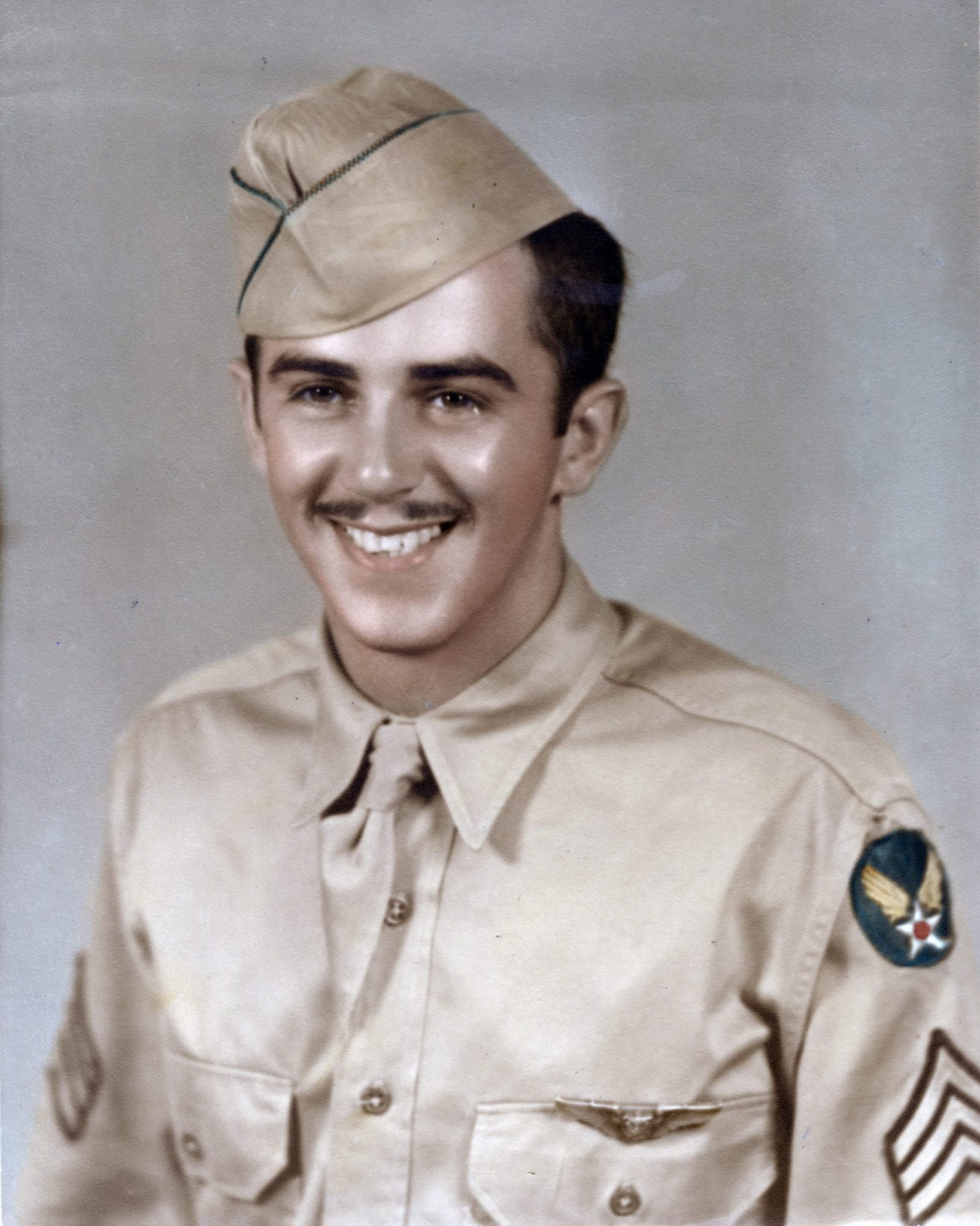
Photo from our Towson and WWII Collection
Known as “Squirrel” to his friends, Fowler spent just a year at STC before enlisting in the United States Army Air Corps in June of 1942.
During his time on campus, he played soccer and was considered an excellent student. In summer, he worked for the Baltimore and Ohio Railroad repairing tracks near his Locust Point neigborhood in Baltimore.
He became a Sergeant in September of 1942, and was made a Staff Sergeant by December. He was an aerial gunner on airplanes first in Hawaii, then Australia, and then finally, in the South Pacific.
“I am stationed in New Guinea,” he wrote to Rebecca Tansil in July of 1943. “Which I find to be anything but a tropical paradise. . . . Like any good airman, I think my crew is the best one America ever sent ‘over'”.
On August 2, 1943, when he was he was killed while flying an aerial raid somewhere over the Pacific Ocean.
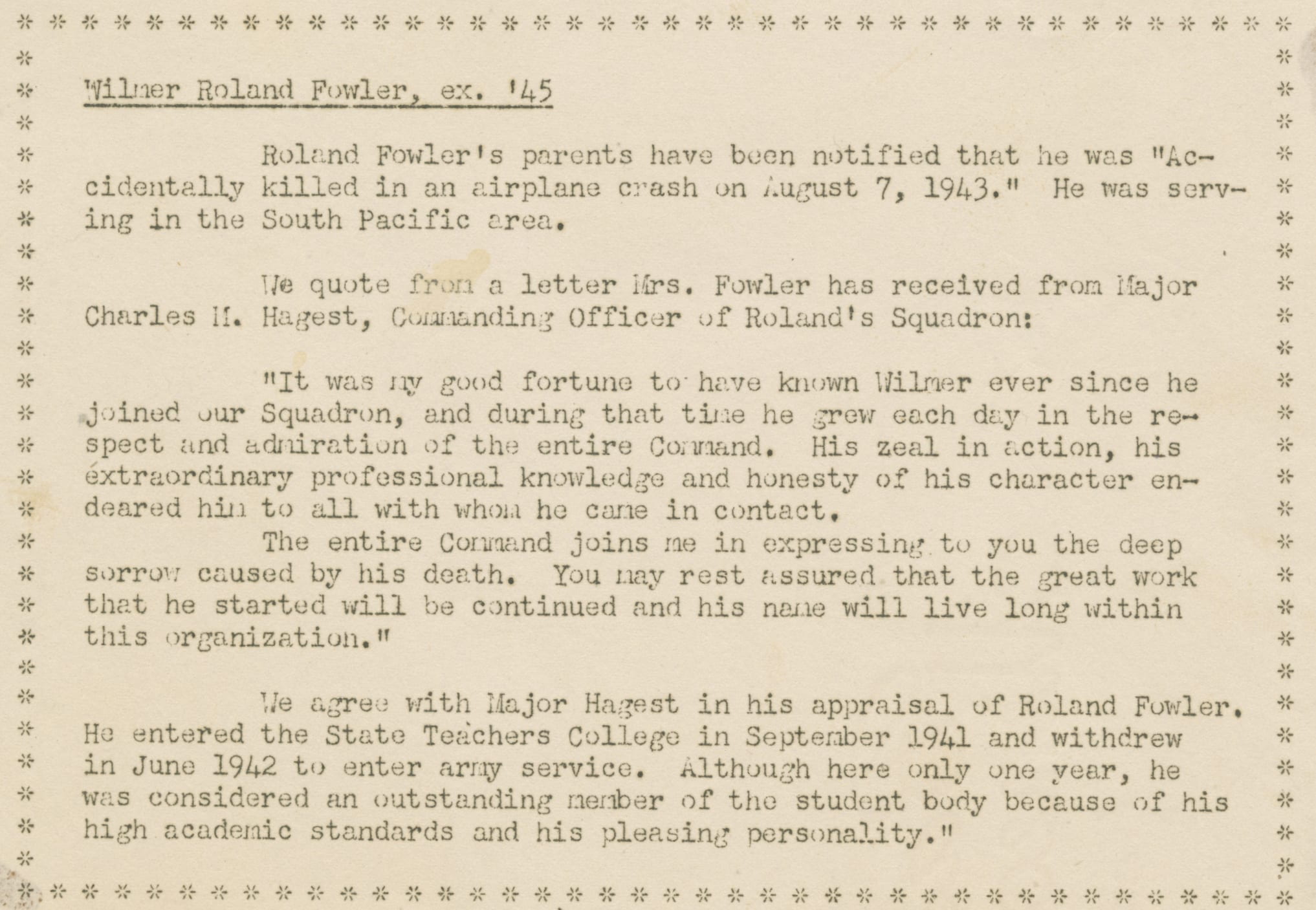
Charles Gross, Class of 1941

Photo from the 1941 yearbook.
Charles Gross loved science, as evidenced by the fact that the first thing he included in his senior biography was the word “electricity”. During his four years at STC, he wrote about updated methods of teaching for the Tower Light and served as an editor for the newspaper as well.
When he enlisted, he spent time teaching mathematics at his boot camp in Alabama. Eventually he was sent overseas and ended up serving in the Pacific Ocean theater. He wrote to Dr. Tansil in 1943, “We are now in the Central Pacific area and it wouldn’t take much of a guess to pinpoint our position. There are towering volcanic mountains on both sides of us and the beautiful blue Pacific at our front door. The vegetaton grows luxuriantly, and at present, during the rainy season, all the fields, and trees, and lawns are greener than I thought they could ever get. You’d like it here I’m sure.”
He appreciated the beauty of his post, but reassured those back at STC that he’d “trade anyone all this just to be back in Baltimore”.
Gross served with the 41st Bomb Squadron and the last letter his mother received from him was written on January 14, 1944 from Tarawa.
He was listed as Missing In Action the following day.

Photo from our Towson and WWII Collection
Robert Norris, Class of 1934
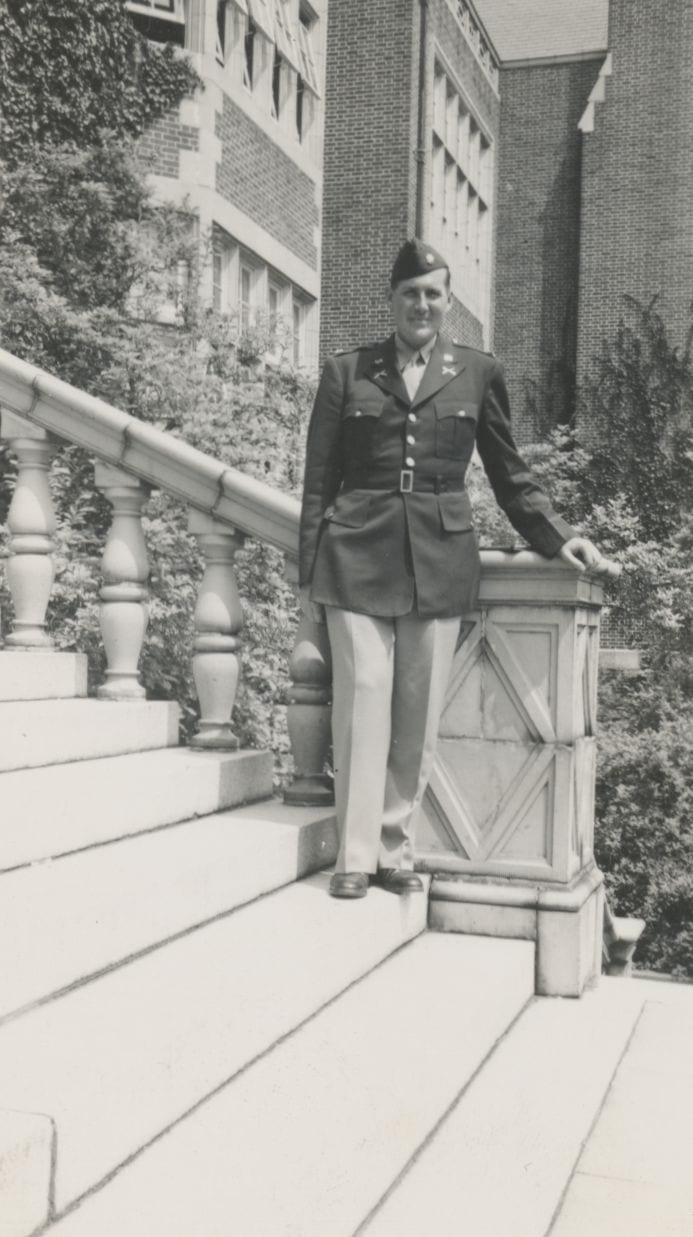
Photo from our Towson and WWII Collection
When he graduated from the Maryland State Normal School (MSNS), Norris was one of 24 men in a class that totaled 199. He graduated one year before the school transitioned to the State Teachers College at Towson, so he earned a teaching certificate for his three years of work at Towson. He later earned a degree at the University of Virginia and was teaching at an elementary school in Anne Arundel County, his home county, when he was called to service.
Norris was a member of the Maryland National Guard and was part of the 29th Infantry Division which mobilized in 1941. He then joined the 318th Infantry, 80th Division. He was promoted to Major in 1943 and was sent to fight the war in Europe.
On August 19, 1944, after the D-Day Invasion and as part of the Battle of the Falaise Pocket, Norris was likely killed in action near Argentan, France.

John Hackman, Class of 1945

Photo from our Towson and WWII Collection
John “Jack” Hackman enlisted in February 1942, when he was still a freshman at STC, just two months after the attack at Pearl Harbor and the US’ entrance into WWII. He joined the US Army Air Forces and was made a pilot in July of 1944.
On October 22, 1944, the Liberator bomber he was co-piloting lost control as it was taking off from an airstrip at the Davis-Monthan Army Air Field in Arizona. The plane burst into flames as it struck the ground, killing six on board, including Hackman.
While he was on campus for only a brief time, he was known as a talented piano player and wrote the song for the Class of 1945.
Six months after his death, his mother wrote to the school:
Jack was very proud of his school and especially so of the splendid record which its students in the armed forces have made. While going thorough training his greatest concern was that he might not be able to live up to that record. When he finally received his wings last June, he seemed to derive more pleasure from knowing that he had not let us, his family, or his school down, than any feeling of personal achievement.
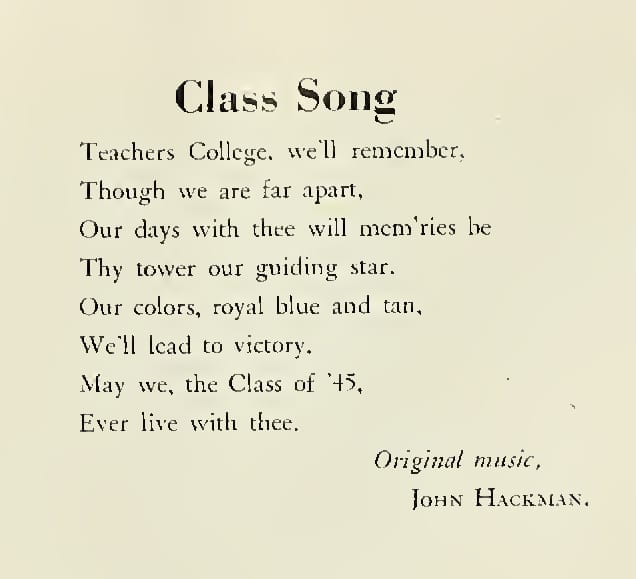
Henry Astrin, Class of 1942, died 4/24/1945
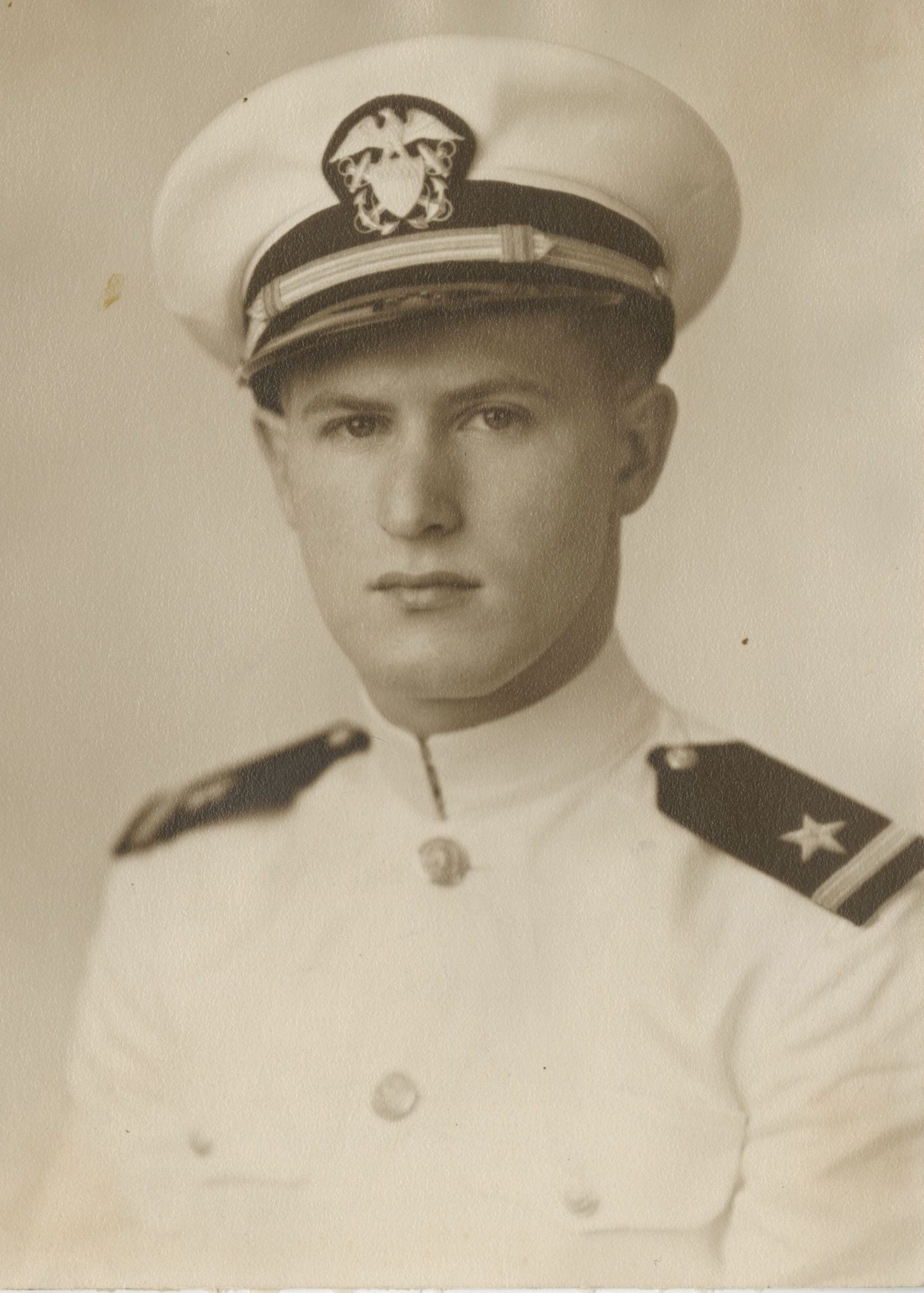
Photo from our Towson and WWII Collection
When Henry Astrin graduated from STC in June of 1942, he was one of 64 men still enrolled in the school. He was a well-known and well-liked student. He played soccer for Doc Minnegan, wrote reviews for the Tower Light of theater performances put on by fellow students, and served as an art editor for the paper as well. During his senior year, he was elected as the president of the Student Government Association. Astrin was devoted to the craft of teaching, to STC, and to his community.
Astrin was a Lieutenant in the US Navy Reserve. He served on the destroyer escort the USS Frederick C. Davis, which was named after one of the service members killed at Pearl Harbor. From its launch in January 1943, the vessel often came under attack as it escorted ships moving between North African ports and Naples, Italy. The Frederick C. Davis was equipped to jam radio frequencies, making it one of the more advanced ships in the fleet.
While serving in the military he kept in regular contact with Dr. Wiedefeld, writing her multi-page letters about the news he received from the school. He congratulated her on the construction of a new gymnasium, and wrote about his concern for a fellow classmate, Luther Cox, who had been captured by German soldiers and sent to a Prisoner of War camp. He seemed keenly aware of the toll the war took on those “back home”, telling her that he realized the “a long interim between short letters . . . . seems to be one of my particular limitations — disastrous in the effect on civilian morale.”
On April 24, 1945, while patrolling the US coastline, the Frederick C. Davis was hit by a torpedo from a German U-boat and split in two.
Henry Astrin was one of the 115 men who died that day.
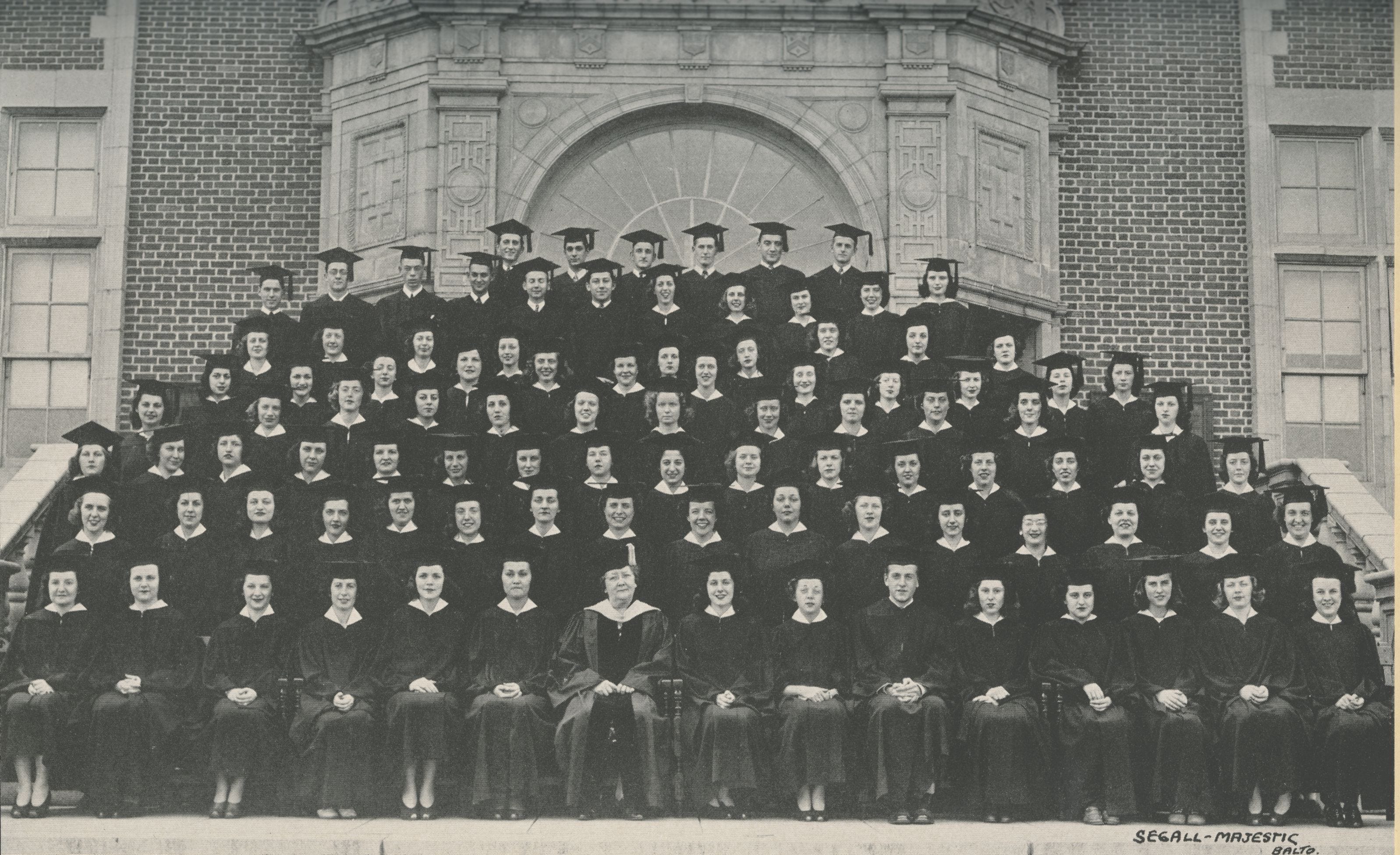
From the June 1942 issue of the Tower Light.
James Saxon, Class of 1968

Photo from the 1968 yearbook.
In 1964, James R. Saxon arrived at Towson State College (TSC) thanks in part to an athletic scholarship. He was a spirited lacrosse player, which was fairly new to TSC’s intercollegiate sports roster. Ultimately, he would serve as captain for the team during his senior year under Coach Carl Runk.
Saxon threw himself into life on campus, playing soccer as well as lacrosse, serving on the Student Government Association as a member-at-large, and also joining and serving as president of Circle K, a service club on campus.
His desire to help people through service is evident in his work as one of the organizers of the Marathon Football weekend that happened each winter. This fundraiser was designed to bring schools from the area together for a weekend of fun with the goal of raising money for Santa Claus Anonymous.
After earning a degree in Business Administration from TSC in 1968, Saxon went on to coach lacrosse and was in graduate school at Bucknell University.
By January of 1971, he’d enlisted and joined the 501st Infantry. He was on his first tour of duty on June 1st, 1971 in Vietnam when he was killed during action in Thừa Thiên-HuếProvince, close to the border with North Vietnam.
In 1983, Saxon was inducted into the Towson University Athletics Hall of Fame.
An endowment scholarship has been created in his honor.

From the Towerlight.
Robert Marchanti, Class of 1989
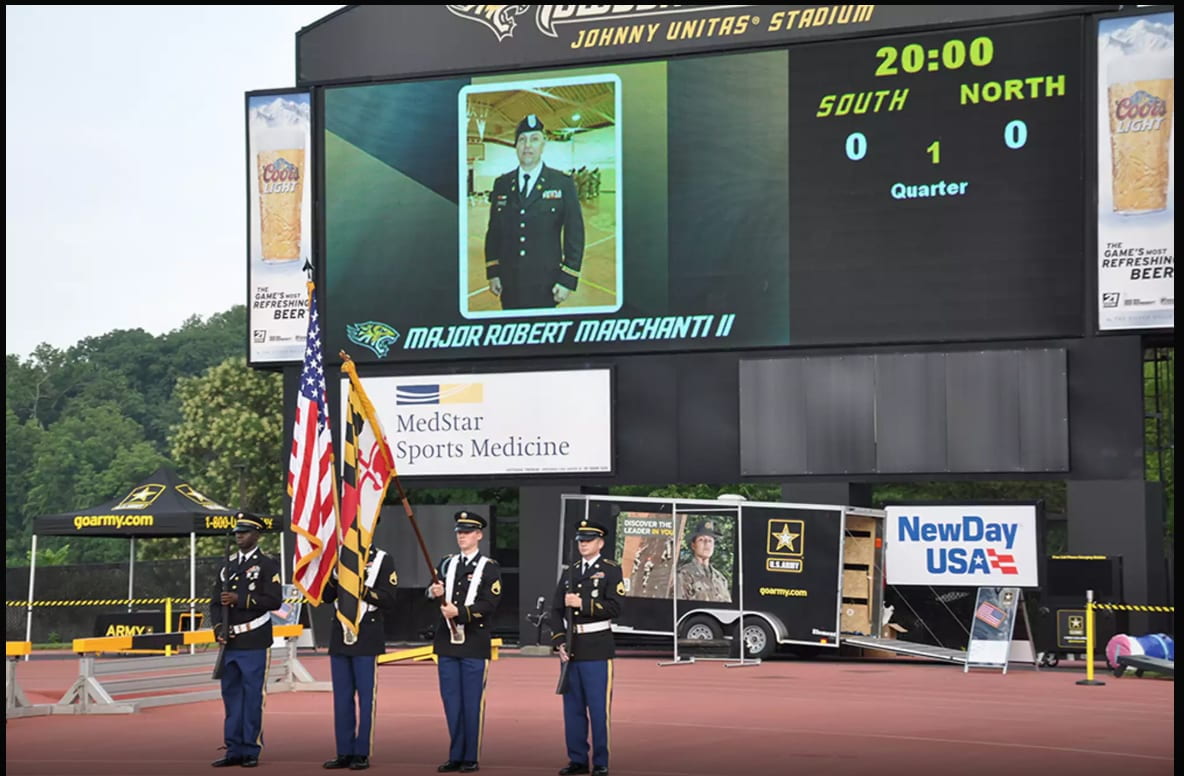
Robert Marchanti attended Towson State University (TSU) after serving in the United States Army and then joining the Maryland National Guard. While at TSU, he joined the wrestling team. After graduating with a degree in Physical Education, Marchanti taught at Baltimore County schools for 17 years. In 2008, he became a full-time employee of the National Guard.
Marchanti was deployed to Afghanistan in 2011 to work with the Afghan National police as part of a NATO mission. On February 25, 2012, he was killed in a ministry building in Kabul.
An endowed scholarship has been created in his honor.
In 2018, Towson University entered a partnership with the Maryland National Guard. On that day, President Schatzel said, “We are looking forward to expanding our partnership with the Maryland Army National Guard to provide important opportunities for continuing education, cyber security training, experiential learning and community outreach.”

Wardell Turner, Class of 1989, died 11/24/2014 in Afghanistan
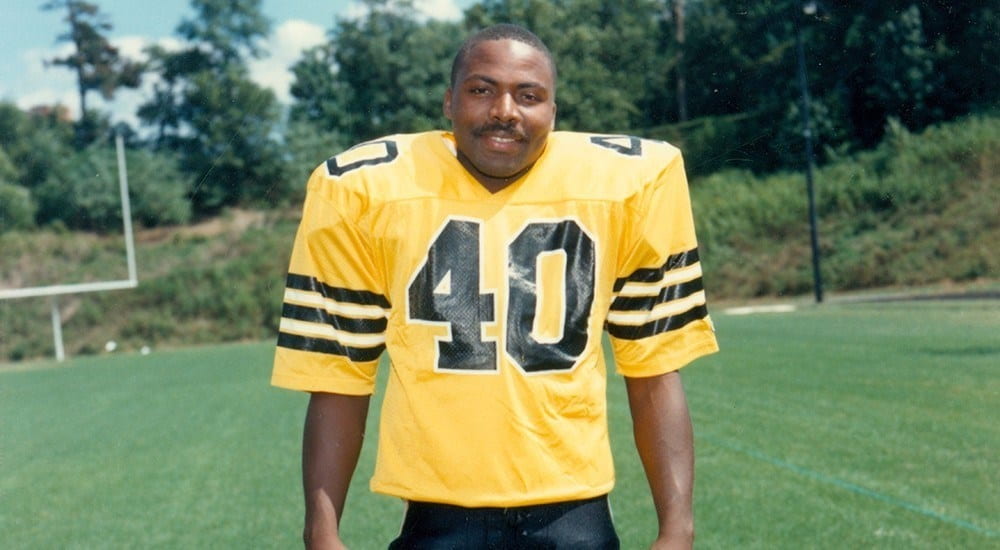
Wardell Turner earned a football scholarship to attend Towson State University after being named the team MVP for his senior year at James M. Bennett High School in Nanticoke, Maryland. That strong record continued at TSU where he played as Defensive Back for the four years he attended.
Turner graduated with a degree in Business Administration in 1989. He enlisted in the US Army in 1993 and remained in service for the next twenty years, and was deployed across the globe, traveling with his wife and children. He was planning to retire after his deployment to Afghanistan in 2014.
On November 24, 2014, Turner was killed by a car bomb in Kabul.
A football scholarship endowment has been created in his honor.
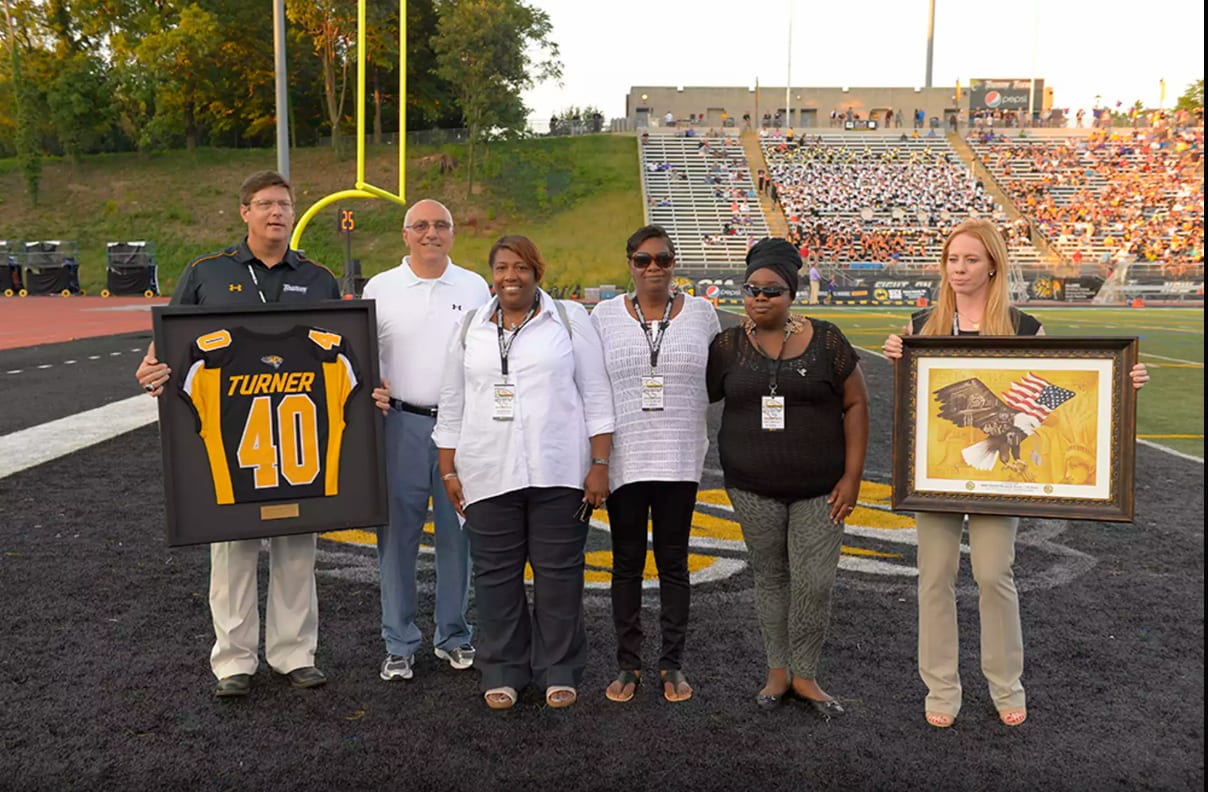
Tracy Miller — Gold Star Mother

This list would be incomplete without mentioning Tracy Miller, recently retired from the Academic Advising Center on campus.
Her son, Nicholas Ziolkowski planned to attend Towson University (TU) after his discharge from the United States Marine Corps. He graduated from Boys’ Latin in 2001, but before starting college, he enlisted, following a lifelong dream. He was serving as a sniper in Fallujah, Iraq when he was struck by an enemy sniper and killed on November 14, 2004.
Miller became an advocate for veteran students at TU and helped re-establish the current Military and Veterans’ Center on campus, something that had fallen by the wayside after Vietnam.
A memorial endowment has been created in Nick Ziolkowski’s honor.